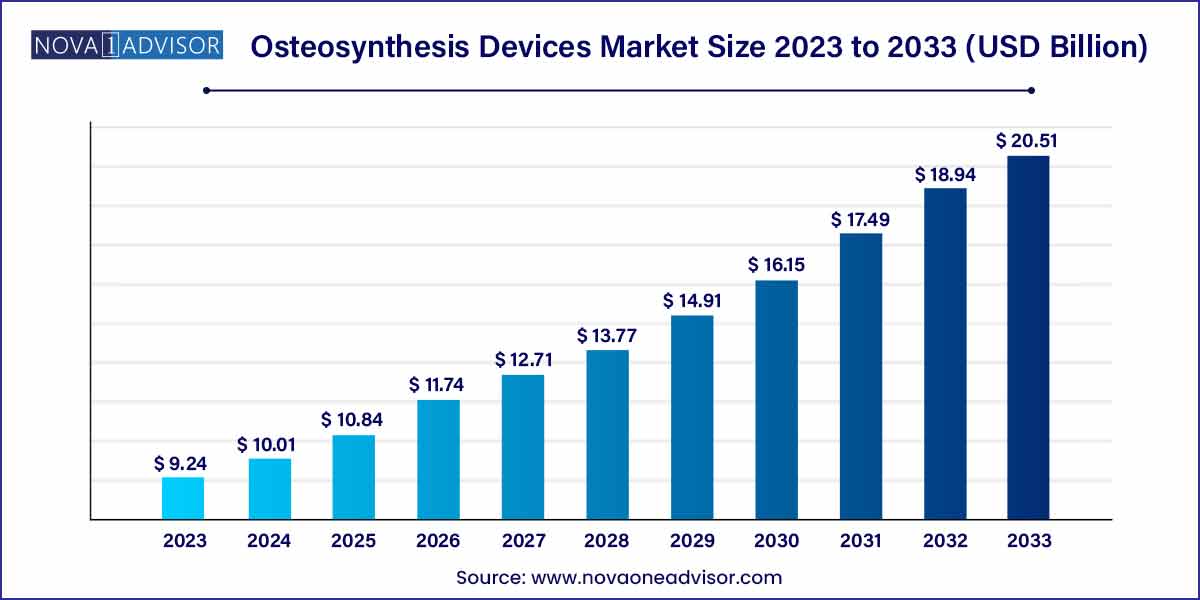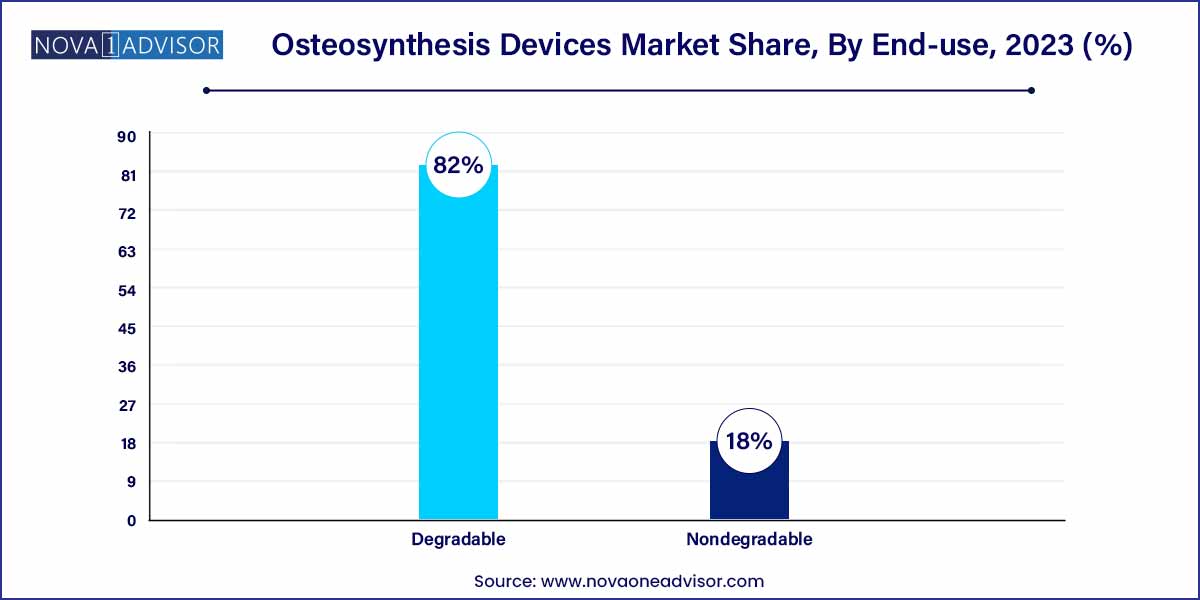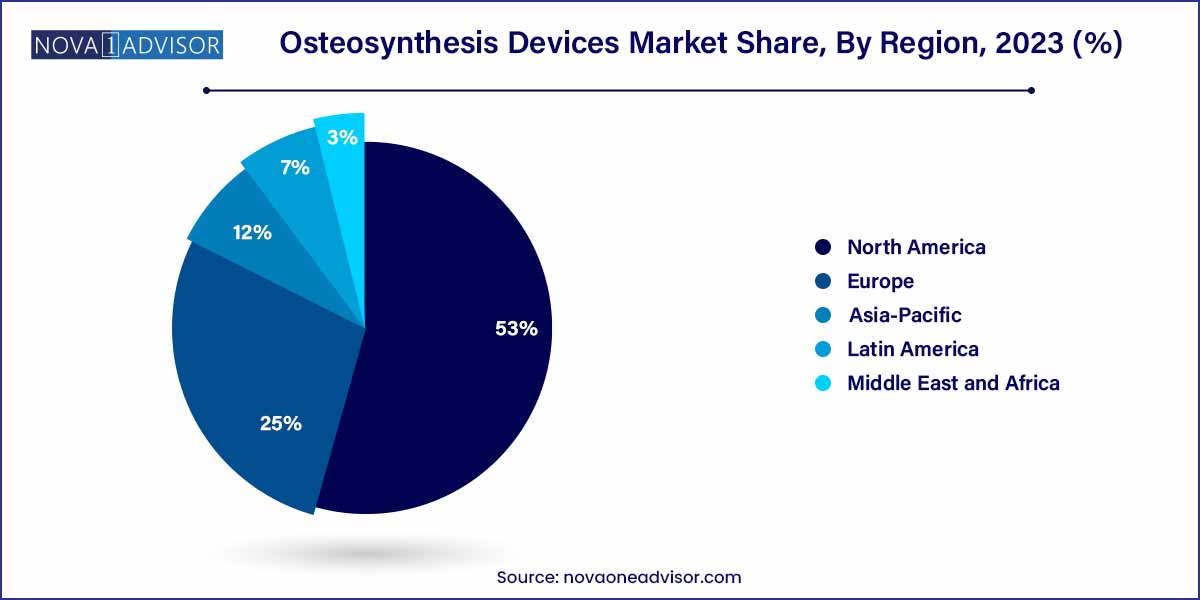The global osteosynthesis devices market size was estimated at USD 9.24 billion in 2023 and is expected to surpass around USD 20.51 billion by 2033 and poised to grow at a compound annual growth rate (CAGR) of 8.3% during the forecast period 2024 to 2033.

Key Takeaways:
- Being the most widely used surgical technique globally, internal fixation equipment accounted for a large revenue share of over 75.2% in 2023.
- In 2023, the non-degradable material products segment represented the largest revenue share of 82.0% of the market.
- The Patella, tibia or fibula, or ankle segment dominated the market and accounted for the largest revenue share of 21.4% in 2023.
- North America dominated the market and accounted for the largest revenue share of 53.0% in 2023.
Market Overview
The osteosynthesis devices market is a critical subset of the orthopedic device industry, focusing on the internal and external fixation of broken or fractured bones. Osteosynthesis is a surgical procedure involving the mechanical stabilization of bone fragments using implants to facilitate the natural healing process. This technique is especially pivotal in complex, open, or non-healing fractures that cannot be managed through conservative treatments. With the increasing incidence of traumatic injuries, sports-related fractures, and age-associated bone fragility disorders such as osteoporosis, the demand for osteosynthesis devices continues to rise.
The market encompasses a broad range of devices, including plates, screws, wires, pins, rods, nails, and spinal fixation systems, as well as external devices for bone lengthening and fracture fixation. Technological innovation has led to the development of bioabsorbable materials, anatomical implants, and minimally invasive systems that reduce surgical trauma and enhance recovery times. Moreover, the increasing aging population, the surge in road accidents, and the proliferation of ambulatory surgical centers are contributing to the market’s expansion.
With a growing preference for early mobility, patients and surgeons are increasingly favoring rigid fixation methods offered by osteosynthesis devices. From trauma and orthopedics to spinal and craniofacial reconstruction, osteosynthesis has become a gold standard of care, making this market a lucrative focus for medtech manufacturers and healthcare providers alike.
Major Trends in the Market
-
Rising demand for minimally invasive orthopedic surgeries using anatomical implants
-
Increased adoption of bioabsorbable and degradable materials for internal fixation
-
Technological advancements in 3D-printed customized osteosynthesis plates and nails
-
Growth in computer-assisted orthopedic surgery (CAOS) and intraoperative navigation tools
-
Expansion of ambulatory surgical centers driving outpatient trauma procedures
-
Greater focus on pediatric osteosynthesis devices with growth-adaptive features
-
Strategic acquisitions and product line extensions by major orthopedic firms
-
Surge in sports injuries and high-impact trauma cases among younger demographics
Osteosynthesis Devices Market Report Scope
Market Driver: Rising Incidence of Bone Fractures and Orthopedic Trauma
A primary driver of the osteosynthesis devices market is the global increase in bone fractures and orthopedic trauma, largely due to an aging population and a rising number of vehicular accidents and sports-related injuries. According to the WHO, road traffic injuries are a leading cause of death among people aged 5–29 years. Fractures in the elderly, often caused by falls, are also increasing in tandem with the growing geriatric population.
Osteosynthesis techniques offer reliable fixation and faster rehabilitation, making them the preferred choice in treating complex fractures. Innovations in device materials and design—such as locking plates and titanium alloy rods—have significantly improved outcomes in patients with osteoporotic bones. As healthcare systems prioritize cost-effective and mobility-focused treatments, osteosynthesis devices remain integral to trauma and elective orthopedic surgery protocols.
Market Restraint: Postoperative Complications and Cost of Implants
While osteosynthesis devices are highly effective, they are not without limitations. Postoperative complications such as infection, implant loosening, nonunion, or malunion of bone fragments can lead to prolonged recovery and revision surgeries. These complications are more common in immunocompromised patients or those with poor bone quality, such as individuals with osteoporosis or diabetes.
Additionally, the cost of osteosynthesis implants especially those made of advanced or biodegradable materials—can be prohibitive in low- and middle-income countries. High implant costs, combined with expensive diagnostic and surgical infrastructure, pose a barrier to adoption. Even in developed markets, reimbursement challenges and pricing pressure from payers and procurement bodies can constrain market growth.
Market Opportunity: Advancements in Biodegradable and Patient-Specific Devices
A major opportunity lies in the development and commercialization of biodegradable osteosynthesis devices that eliminate the need for implant removal surgeries. These devices, typically made from polylactic acid (PLA) or magnesium alloys, gradually dissolve in the body as the bone heals. Such innovation is especially valuable in pediatric cases and craniofacial surgery, where permanent implants may not be desirable.
Additionally, the use of 3D printing and imaging-based design is enabling the creation of patient-specific implants that precisely match anatomical contours. Custom plates and fixation devices reduce intraoperative adjustments, shorten surgical times, and enhance fixation stability. As additive manufacturing matures and regulatory pathways streamline, the commercialization of such bespoke osteosynthesis solutions is expected to accelerate.
By Type Insights
Internal devices dominate the osteosynthesis market, due to their superior ability to stabilize fractures from within the body. Screws and plates are the most commonly used implants in trauma and orthopedic surgery, followed closely by intramedullary nails and spinal fixation systems. Their widespread application across femoral, tibial, humeral, and vertebral fractures makes internal fixation devices indispensable. With improved material strength, corrosion resistance, and bio-compatibility, modern internal fixation systems provide reliable support and minimize the need for secondary surgeries.
External devices are the fastest-growing segment, driven by their use in complex fractures, non-unions, and bone lengthening procedures. These devices, including external fixators and distraction systems, offer flexibility in managing unstable fractures, particularly in high-energy trauma. Innovations in hybrid external fixators and lighter-weight carbon fiber systems are improving patient comfort and allowing earlier mobility. Their application in battlefield injuries and low-resource settings further contributes to their expanding market presence.
By Material Insights
Nondegradable materials, such as stainless steel and titanium, currently dominate due to their mechanical strength, durability, and proven long-term biocompatibility. These materials are favored in load-bearing applications like femur and hip fractures and are supported by well-established surgical protocols. Titanium, in particular, offers a balance of strength and light weight, making it ideal for spinal and cranial applications.

Degradable materials are the fastest-growing, as they eliminate the need for implant removal and reduce long-term complications. PLA-based resorbable screws and pins are increasingly used in pediatric orthopedics and maxillofacial surgery. With ongoing research in magnesium alloys and bioceramics, the scope of degradable devices is widening. These implants offer improved osteointegration and reduce surgical burden, aligning with the growing demand for minimally invasive and patient-friendly solutions.
By Fracture Type Insights
Femur fractures, particularly those outside the femoral neck, dominate the market, owing to the high prevalence of hip and thigh injuries in elderly patients and trauma victims. These fractures often require intramedullary nails or locking compression plates for effective stabilization. Early mobilization, reduced hospital stay, and decreased morbidity rates are achieved through internal osteosynthesis, making it the gold standard for femoral repairs.
Fractures of the vertebral column and pelvis are the fastest-growing categories, especially with the rise in spinal injuries from motor accidents, falls, and degenerative diseases. Spinal fixation devices, such as pedicle screws and rods, are increasingly used in vertebral fractures, while pelvic fracture stabilization benefits from advanced plating systems and image-guided techniques. These segments are witnessing substantial investment in robotic-assisted surgeries and intraoperative 3D navigation systems.
By Regional Insights
North America dominates the osteosynthesis devices market, supported by a well-developed healthcare infrastructure, high prevalence of trauma and degenerative orthopedic conditions, and early adoption of advanced medical technologies. The U.S. leads in terms of revenue, with strong reimbursement systems, a large aging population, and significant market penetration by companies like Stryker, Zimmer Biomet, and Johnson & Johnson.

Asia-Pacific is the fastest-growing region, fueled by a growing elderly population, rising road accident rates, and increased healthcare investments. Countries such as China, India, and Japan are experiencing a surge in orthopedic surgeries, supported by government-led initiatives to expand hospital capacity and trauma centers. Additionally, local manufacturing and more affordable pricing models are enabling greater access to osteosynthesis solutions across emerging economies.
Some of the prominent players in the osteosynthesis device market include:
- DePuy Synthes, Inc. (J & J Company)
- Stryker
- Zimmer Biomet Inc.
- Smith & Nephew
- GS Medical LLC
- Life Spine, Inc.
- MicroPort Orthopedics, Inc
- Precision Spine, Inc
- Globus Medical, Inc.
- Arthrex
- Medtronic
- Olympus Corporation
- Lepu Medical Technology (Beijing) Co., Ltd.
Recent Developments
-
In April 2025, Stryker Corporation launched a new bioresorbable plating system for pediatric fracture management in Europe.
-
In March 2025, Zimmer Biomet introduced its next-generation robotic-assisted trauma surgery platform designed for lower extremity fracture repair.
-
In January 2025, Depuy Synthes (Johnson & Johnson) announced a collaboration with Materialise to co-develop patient-specific 3D-printed osteosynthesis implants.
-
In November 2024, Smith & Nephew expanded its EVOS mini plating system with additional indications for facial bone fixation.
-
In September 2024, Medtronic received FDA clearance for its AI-integrated spinal fixation system optimized for trauma applications.
Segments Covered in the Report
This report forecasts revenue growth at global, regional, and country levels and provides an analysis of the latest industry trends in each of the sub-segments from 2021 to 2033. For this study, Nova one advisor, Inc. has segmented the global Osteosynthesis device market.
Type
-
- Screws & Plates
- Wires & pins
- Intramedullary rods and nails
- Spinal fixation devices
-
- Fracture fixation
- Bone lengthening
Material
Fracture Type
- Skull
- Facial bones
- Sternum or one or more ribs, or both
- Clavicle, scapula, or humerus
- Radius or ulna, or both
- Hand, wrist, or other distal part of hand
- Vertebral column
- Pelvis
- Hip
- Femur, other than femoral neck
- Patella, tibia or fibula, or ankle
- Foot bones except ankle
By Region
- North America
- Europe
- Asia-Pacific
- Latin America
- Middle East & Africa (MEA)



